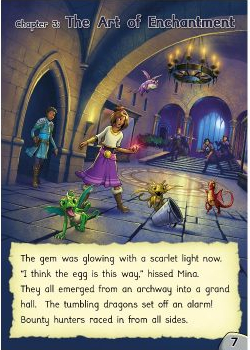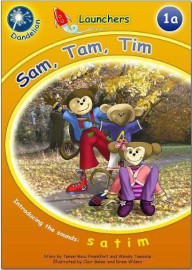PhonicBooks® publishes four different series of readers for beginners that can be used in about kindergarten through third grade. The first series has three sets of readers, the second series has four sets, the third series has only one set, and the fourth has three. The readers are designed to catch the interest of children, so they feature large, full-color illustrations, many of which take up most of the page as in children’s picture books. Each set of readers focuses on specific phonetic concepts while incorporating some sight words. These readers should be useful for reading practice alongside most phonics-based reading programs. PhonicBooks also publishes multiple series of readers for older students, called Catch-Up Readers, that I review separately.
Each set of readers has an optional companion workbook that reinforces the concepts covered within each set of readers.
Dandelion Launchers and Dandelion World
Dandelion Launchers, one of two possible starting places for beginning readers, is a series that uses short-vowel words almost exclusively. There are three sets of readers and a workbook for each set. The first set has 14 readers, the second set has 16, and the third set has 10. The readers are each ten pages long, including content on both inside covers. All of these readers have a game on the last two pages that helps children practice reading the words that represent the phonetic focus of the reader. The game can be used before or after a child reads the book. Most of the stories feature talking animals and have one sentence of text per page. However, the third set generally expands the text to two sentences per page.
The first set of readers begins with consonant-vowel-consonant (CVC) words, such as sat, bat, and nut, and it includes words that end with double consonants, such as buzz, doll, and kiss. The second set introduces CVCC words, such as land, junk, and lift. Readers in the second set use words that include phonograms, such as th, wh, and qu. The third set introduces words with tch, ve, and le. It also teaches many two-syllable words and words with ing and ed suffixes, such as sandpit, wobbled, and dropped.
All three workbooks for this series have decoding, comprehension, and writing activities, and the second and third workbooks add some activities for spelling.
The Dandelion World Readers parallel the Dandelion Launchers series in terms of teaching reading skills. They also have the same number of sets and books per set. However, they use non-fiction content such as cats, camping, and sloths. (Available mid-December 2023)
Dandelion Readers
The four sets of Dandelion Readers focus on words with long-vowel sounds, vowel combinations such as ou and ai, and some of the more unusual vowel sounds. There are six readers in the first set. Each of the first five of these readers introduces words that have only one of the long-vowel sounds and that make that sound using vowel-consonant-vowel combinations, such as in the words cake, broke, flame, and these. The sixth reader uses words with all five long-vowel sounds.
The other three sets of readers in this series each have 12 readers. They feature words that include two-vowel phonograms such as ai, ee, ie, oo, oi, and ea as well as other phonograms such as igh, aw, ir, ur, and ar. Children will be reading words such as mail, tree, oil, groan, great, wood, and night.
The stories feature human characters, talking animals, and robots, and each page has up to four sentences. The last two pages of each reader have a game that should support what students are learning and be fun to play. The workbooks for these four series have activities for phonics, reading practice, comprehension, and spelling.
Dragon Eggs
 The Dragon Eggs series should be used to help children develop reading fluency. There are ten readers in just one set. Each of the readers uses many words that make the same vowel sound but with different spellings. For example, the first reader focuses on the long a sound as in the words day, lazy, great, they, stain, and amaze.
The Dragon Eggs series should be used to help children develop reading fluency. There are ten readers in just one set. Each of the readers uses many words that make the same vowel sound but with different spellings. For example, the first reader focuses on the long a sound as in the words day, lazy, great, they, stain, and amaze.
This series has a continuing storyline featuring Mina and her quest to find lost dragon eggs. This fantasy story is full of adventure and excitement. Even though it is recommended for ages five through seven, I expect that children up to about ages nine or ten will enjoy the story.
The workbook for this series has activities for word building, spelling, and reading comprehension.
Phonics Instructional Manuals
Three Phonics Instructional Manuals have been written for use with Phonic Books readers. The first two, subtitled Kindergarten and Grade 1, are for beginning readers, and the third is for older students using the Catch-Up readers. The first two manuals pertain to this review since they were designed for use with the various Dandelion sets of readers and their companion workbooks. The lesson plans can also be adapted for use with other phonics programs.
These two manuals (about 200 pages each) are helpful for those who want to provide comprehensive reading instruction, especially for class groups. They provide extensive background information about teaching phonics and the particular strategies used with Phonic Books. Homeschoolers are likely to be most interested in the daily lesson plans that cover all aspects of reading plus spelling. Several reproducible reading assessments are also included for each series of readers.
Games
PhonicBooks publishes two types of games that can be used alongside these readers. You can read my review of the games here. I highly recommend the games for young readers, and I found the book-based games especially useful.
Summary
PhonicBooks readers are very eye catching with their great illustrations, and many of them have interesting storylines. Both features are likely to make these readers popular with children. In addition, they are solidly based on phonics and can be used on their own, with the Phonic Books instructional manuals, with resources such as Phonics Pathways and Teach Your Child to Read in 100 Easy Lessons, and with more-comprehensive phonics programs.









